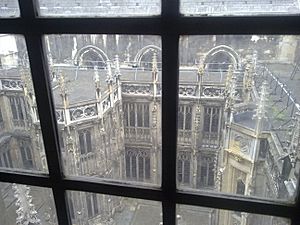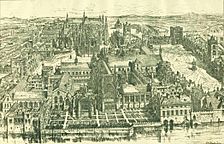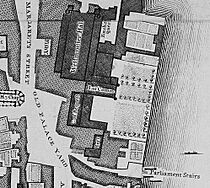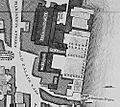St Stephen's Chapel facts for kids
St Stephen's Chapel was an important building in the old Palace of Westminster in London. It was finished around the year 1297. For many years, after King Henry VIII died, this building was used as the main meeting room for the House of Commons. This is where important decisions about the country were made.
Sadly, a big fire in 1834 mostly destroyed the chapel. But a part of it, the Chapel of St Mary Undercroft in the crypt (an underground room), survived. Today, the area where the chapel once stood is part of the new Palace of Westminster. This new part is called St Stephen's Hall. It's the public entrance for visitors to the House of Commons.
Contents
History of St Stephen's Chapel

How St Stephen's Chapel Began
King Henry III visited a beautiful chapel in Paris in 1248. He was so impressed that he wanted to build a similar chapel in his own palace at Westminster. Work on St Stephen's Chapel continued for many years. It was finally completed around 1297.
The chapel had two levels. The top level was used by the Royal Family. The lower level was for the Royal Household and other important people at court.
Important Events at the Chapel
St Stephen's Chapel was the setting for several important historical moments.
Royal Weddings and Funerals
Two royal weddings took place here. On January 20, 1382, King Richard II married Anne of Bohemia. He was 15, and she was 16. Another wedding happened on January 15, 1478. This was between Richard, Duke of York, and Anne Mowbray. Richard was one of the "Princes in the Tower". Anne was five years old, and Richard was a bit younger. Anne sadly died when she was eight.
The body of King Edward IV, Richard's father, was brought to St Stephen's Chapel after he died in 1483. It stayed there for eight days before being buried.
Chapel Becomes the House of Commons
Thomas Cranmer became Archbishop of Canterbury in St Stephen's Chapel on March 30, 1533. After King Henry VIII died, the Palace of Westminster was no longer a royal home. King Edward VI, Henry's son, made new laws that closed many chapels. Because of these laws, St Stephen's Chapel became available. It was then used as the main meeting room for the House of Commons.
A Suffragist's Protest
On the night before the 1911 census, a woman named Emily Davison hid in a broom cupboard in the chapel's crypt. She was a suffragist, fighting for women's right to vote. By staying there, she could list her address as the House of Commons. This was a symbolic act, as women were not allowed to be Members of Parliament or even vote at that time. A small plaque was later placed in the cupboard to remember her protest.
The House of Commons Chamber
The way the old chapel was built greatly influenced how the House of Commons works today. The Speaker's chair, where the person in charge of debates sits, was placed where the altar used to be. This is why Members of Parliament (MPs) still bow to the Speaker. The Table of the House, where important documents are placed, was put where a lectern once stood.
MPs sat facing each other in the old choir stalls. This created the "two-sides" seating arrangement we still see in the Commons chamber today. The old screen, which had two doors, was also kept. This became the basis for how MPs vote. Those who vote "aye" (yes) go through one door, and those who vote "no" go through the other.
Changes to the Chapel's Design
Between 1547 and 1834, the chapel was changed many times to fit the needs of the House of Commons. At first, the changes were small. The old church furniture was removed, and the walls were painted white. Stained-glass windows were replaced with plain glass.
Later, in the 1690s, big changes were made by an architect named Christopher Wren. The building was made shorter, and its tall windows were blocked up. Smaller windows were cut into the new walls. Inside, the walls were made thinner to add more seats. Galleries were built on the upper level for male visitors to watch the debates. The beautiful medieval decorations were hidden behind wooden panels. A false ceiling was added to improve the sound in the room. The space above this ceiling was used as a gallery for women, but the view was very limited. More seats were added over time as the number of MPs grew. By the 1800s, the chapel's inside looked very plain, not at all like its grand medieval past.
The Fire and Rebuilding
A huge fire in 1834 completely destroyed the main part of St Stephen's Chapel. Only the crypt below and the nearby cloisters (covered walkways) barely survived. One of the few things saved from the fire was the Table of the House. It is now kept in the Speaker's apartments.
Even though the chapel was torn down after the fire, its surviving stone walls showed the original medieval decorations that had been hidden for centuries. Many people came to see them. The chapel's history was remembered when the new Palace of Westminster was designed. St Stephen's Hall, a grand public entrance, was built on the same spot as the old chapel. The place where the Speaker's chair used to be is even marked on the floor.
The crypt below St Stephen's Hall, called the Chapel of St Mary Undercroft, was repaired and is still used as a place of worship today. Children of peers (members of the nobility) can even get married there. Members of Parliament and peers can also have their babies christened there.
The body of former Prime Minister Margaret Thatcher was kept in St Mary Undercroft the night before her funeral in 2013.
Images for kids
See also
 In Spanish: Capilla de San Esteban para niños
In Spanish: Capilla de San Esteban para niños






